#active cases in india
Explore tagged Tumblr posts
Text
Resisting the urge to carve myself a distaff from one of the evergreen boughs ive dragged home and learn medieval in-hand distaff spinning. Do i need to do any of this ? No. Am i happy with supported spinning ? Yes ! Am i probably gonna do it anyway ? ... also yes
#we talk a lot about the rabbit hole of fiber arts#but i dont think we talk enough about the rabbit hole of different spinning tools and techniques...#so far id say ive gotten proficient in drop spindling wheel spinning and supported spinning with russian style spindles#really want to get into either tahklis or charkah wheels#bc im gonna be visiting my wonderful fiancé in india and hes still gonna have work for most if not all of the time im there#so my plan is to spin a LOT. hoping to get really proficient in cotton spinning bc ive always really sucked at that#and then i really wanna learn medieval style spinning as well#if i was an academic i could easily see myself devoting my life to writing a book about spinning tools through the ages#i am so endlessly fascinated by it#but also really bad at research and have a pretty crippling case of dyslexia#i wanna try. all the tools#it always feels like the way to get closer to the past is to spin like them#since that has been THE constant human activity since quite possibly pre-homo sapiens times#i dont know how much cloth the neanderthals wove or if they were more inclined to use animal skins#but we do know they made yarn and they were good at it#sadly my hands cant do cordage. fucks em up in about a minute flat#but iirc we've found stone spindle whorls which may have been used for spinning#stone whorls can also be used for hand drills and fire starters and things like that so idk#anyway. i just want to know SO badly#spinning
38 notes
·
View notes
Text
Unveiling the Latest Innovations: What is New in Rig Wash Additive Technology
In the dynamic and ever-evolving oil and gas industry, maintaining clean and efficient drilling operations is paramount. One of the critical aspects of this process is the use of specialized additives to ensure the integrity and cleanliness of drilling equipment. As a leading pipe free agent additive manufacturer in India, Imperial Oilfield Chemicals Pvt. Ltd. is at the forefront of developing innovative solutions that enhance the performance and reliability of drilling operations. This blog explores the latest advancements in rig wash additive technology and their impact on the industry.

The Importance of Rig Wash Additives
Rig wash additives play a crucial role in the maintenance of drilling rigs and associated equipment. These chemicals are designed to remove contaminants such as oil, grease, and drilling mud from surfaces, ensuring that the equipment operates efficiently and safely. By preventing the build-up of residues, rig wash additives help to extend the lifespan of equipment, reduce maintenance costs, and minimize downtime.
Key Benefits of Rig Wash Additives:
Enhanced Equipment Performance: Clean equipment operates more efficiently, leading to improved overall performance.
Reduced Maintenance Costs: Regular cleaning with effective additives reduces the need for frequent repairs and maintenance.
Safety: Clean rigs and equipment help prevent accidents and ensure a safer working environment.
Environmental Compliance: High-quality rig wash additives help in adhering to environmental regulations by ensuring proper disposal of contaminants.
Innovations in Rig Wash Additive Technology
The oilfield chemicals industry is constantly advancing, with new technologies and formulations emerging to address the specific needs of modern drilling operations. As a leading rig wash additive manufacturer in India, Imperial Oilfield Chemicals Pvt. Ltd. is committed to staying at the cutting edge of these innovations. Here are some of the latest developments in rig wash additive technology:
Environmentally Friendly Formulations
With increasing environmental regulations and the industry's shift towards sustainable practices, there is a growing demand for environmentally friendly rig wash additives. Manufacturers are now focusing on developing biodegradable and non-toxic formulations that effectively clean equipment without harming the environment.
Features of Eco-Friendly Rig Wash Additives:
Biodegradable Ingredients: Break down naturally without leaving harmful residues.
Non-Toxic: Safe for use around personnel and wildlife.
Low VOCs: Reduced volatile organic compounds to minimize air pollution.
Enhanced Cleaning Efficiency
The efficiency of rig wash additives is critical to their performance. Recent advancements have led to the development of high-performance additives that offer superior cleaning capabilities. These formulations are designed to penetrate and remove even the most stubborn contaminants, ensuring that equipment remains in optimal condition.
Key Characteristics:
High Penetration: Ability to reach and clean hard-to-access areas.
Superior Solvency: Effectively dissolves oil, grease, and other residues.
Quick Action: Reduces cleaning time, enhancing operational efficiency.
Multi-Purpose Additives
To simplify the maintenance process and reduce costs, there is a trend towards multi-purpose rig wash additives. These versatile formulations can be used for various cleaning applications, from washing rigs to cleaning pipelines and casings.
Advantages of Multi-Purpose Additives:
Cost-Effective: Reduces the need for multiple products.
Simplified Logistics: Easier inventory management and storage.
Consistent Performance: Ensures uniform cleaning results across different applications.
Specialized Additives for Specific Applications
Recognizing that different components of drilling operations may require unique cleaning solutions, manufacturers are developing specialized additives tailored to specific applications. For example, a casing wash additive manufacturer in India might produce formulations specifically designed to clean and protect casing pipes, ensuring their longevity and performance.
Examples of Specialized Additives:
Casing Wash Additives: Formulated to clean and protect casing pipes from corrosion and build-up.
Pipe Free Agent Additives: Designed to prevent the formation of hydrates and other blockages in pipelines.
Rig Wash Additives: Targeted formulations for cleaning drilling rigs and related equipment.
Imperial Oilfield Chemicals Pvt. Ltd.: Leading the Way
As a premier pipe free agent additive manufacturer in India, Imperial Oilfield Chemicals Pvt. Ltd. is dedicated to innovation and excellence. Our range of rig wash additives is formulated to meet the highest standards of performance and safety, ensuring that our clients can maintain efficient and reliable operations.
Our Product Range:
Rig Wash Additives
Our rig wash additives are designed to remove a wide range of contaminants, from oil and grease to drilling mud. They are formulated to provide thorough cleaning while being safe for both equipment and the environment.
Casing Wash Additives
Our casing wash additives are specifically designed to clean casing pipes, preventing corrosion and build-up that can compromise the integrity of the pipes. These additives are essential for maintaining the safety and efficiency of drilling operations.
Pipe Free Agent Additives
Our pipe free agent additives prevent the formation of hydrates and other blockages in pipelines, ensuring smooth and uninterrupted flow. These additives are critical for maintaining the efficiency and reliability of pipeline operations.
Case Study: Successful Implementation of Rig Wash Additives
To illustrate the impact of our innovative rig wash additives, let's consider a case study involving a major drilling operation in India. The client faced significant challenges with equipment contamination, leading to frequent maintenance and downtime.
The Challenge:
Frequent Downtime: Equipment contamination caused frequent shutdowns for cleaning and maintenance.
High Maintenance Costs: Regular repairs and part replacements due to build-up and corrosion.
Environmental Concerns: Need for environmentally friendly cleaning solutions.
The Solution:
Imperial Oilfield Chemicals Pvt. Ltd. provided a comprehensive solution with our range of rig wash and casing wash additives. The implementation involved:
Regular Cleaning Schedule: Establishing a routine cleaning schedule using our high-performance additives.
Training and Support: Providing training to the client's staff on the proper use of the additives and best cleaning practices.
Environmental Compliance: Ensuring that the products used were environmentally friendly and compliant with local regulations.
The Results:
Reduced Downtime: The client experienced a significant reduction in equipment downtime, leading to uninterrupted operations.
Lower Maintenance Costs: The effective cleaning reduced the need for frequent repairs and part replacements, resulting in cost savings.
Enhanced Safety and Compliance: The use of eco-friendly additives ensured a safer working environment and compliance with environmental regulations.
Future Trends in Rig Wash Additive Technology
The future of rig wash additive technology looks promising, with ongoing research and development aimed at addressing the evolving needs of the oil and gas industry. Here are some trends to watch:
Smart Additives
The integration of smart technologies into rig wash additives is an exciting development. These additives can be designed to change their properties in response to specific conditions, enhancing their effectiveness and efficiency.
Nano-Technology
Nano-technology is set to revolutionize rig wash additives by enabling the development of formulations with enhanced penetration and cleaning capabilities. Nano-particles can reach and clean areas that traditional additives cannot, ensuring thorough cleaning.
Sustainability Focus
As environmental concerns continue to grow, there will be an increased focus on developing sustainable rig wash additives. This includes not only biodegradable and non-toxic formulations but also products that require less water and energy for their application.
Conclusion
The advancements in rig wash additive technology are transforming the oil and gas industry, making drilling operations more efficient, safe, and environmentally friendly. As a leading rig wash additive manufacturer in India, Imperial Oilfield Chemicals Pvt. Ltd. is proud to be at the forefront of these innovations. Our commitment to quality, performance, and sustainability ensures that our clients receive the best possible solutions for their cleaning needs.
Whether you are looking for a pipe free agent additive manufacturer in India or a casing wash additive manufacturer in India, Imperial Oilfield Chemicals Pvt. Ltd. has the expertise and products to meet your requirements. Stay ahead of the curve with our innovative rig wash additives and experience the difference they can make in your operations.
#Pipe free agent additive manufacturer in India#Rig wash additive manufacturer in India#Casing wash additive manufacturer in India#petrochemical products#petrochemical companies#petrochemical industries#petrochemical solutions#oil and gas industry#oil and gas companies#chemical product#chemical industry#chemical companies#oil & gas supply chain#India#Upstream activities#exploration and production#upstream oil and gas segment#upstream oil and gas industry
4 notes
·
View notes
Text
one last word on this. it is very interesting to me that it is imane khelif (an allegedly intersex algerian person with an androgynous physique) who has been chosen by radfems to give a face to the problem of sexism at the olympics and not steven van de velde, the athlete convicted of raping a child, not "valentina" petrillo, the actual transwoman competing at the female paralympics, not manizha talash, the female afghan athlete who was eliminated from the competition for wearing a cape that said "free afghan women", not vinesh phogat, the female indian athlete who was excluded from the competition because she was 100g overweight as she was about to win a gold medal (a decision that may have been politically motivated considering phogat has been very vocal and active protesting sexual violence in indian society), not the inclusion of israeli players who represent a country that commits mass rapes on palestinian women.
When you bring that up the counter-argument is always "yes but radfems are opposed to the inclusion of khelif and at the same time they denounce these other forms of sexism, we can care about multiple issues at once" except that this is absolutely not the case here, feminists have devoted much, much more time, attention and conversation to khelif than to any other people i've mentioned here, they have protested much more against khelif than against the men or in support of the women I have listed. This shows that radfems (in general) have made the choice to give a greater priority to khelif than to these other questions, and this shows that their priorities really speak to white middle class women much more than they do disabled women, woc, third world and working class women.
Because even if khelif had been a biological male identifying as a woman (which isn't the case)... none of this warrants focusing so much on her. all the other topics i've mentioned here have only been discussed from time to time at best (for van de velde and petrillo) and a couple of times before everyone decided to collectively move on at worst (for talash and phogat). Of course fair play for women is important but it shouldn't obliterate every other conversation to be had about male violence, especially male violence occuring in third world countries in large part because of western imperialism (in the cases of afghanistan, india and palestine)
198 notes
·
View notes
Text
[ThePrint is Indian Private Media]
Speaking to ThePrint minutes after Hasina left Bangladesh, Yunus, who has been charged by the Hasina government in over 190 cases, said, “Bangladesh is liberated… We are a free country now.”
“We were an occupied country as long as she (Hasina) was there. She was behaving like an occupation force, a dictator, a general, controlling everything. Today all the people of Bangladesh feel liberated.”[...]
Yunus was convicted by the Hasina-led government in January for violating the country’s labour laws and is currently out on bail.[...]
Yunus, founder of the pioneering microfinance system that lifted millions of poor out of poverty in Bangladesh, ruled out any role in active politics. “I’m not the kind of person who would like to be in politics. Politics is not my cup of tea,” he maintained.
Currently in Paris, he said he would soon return to Bangladesh and continue to work for the people the way he did earlier.[...]
“I will continue with my work in a more free environment that I didn’t have during the regime of Sheikh Hasina because she was always attacking me. I will continue, devote myself to the things I could not do before,” he said.
Earlier in the day, coming down heavily on the Hasina-led government, Yunus had in a separate interview with ThePrint demanded that she resign immediately.[...]
He added that unlike the US, India has played a “major role” as far as Bangladesh is concerned.
“I don’t know what role they are playing now in this scenario and what role they will play in the upcoming situation,” he told ThePrint.[...]
The Nobel Laureate said that with Hasina no longer calling the shots in Dhaka, things have changed in Bangladesh and he is not sure what role opposition parties including former PM Khaleda Zia’s Bangladesh Nationalist Party (BNP) will play in the current scenario.
He added that the BNP was silent so far because they have been under attack all along. “Now in a free country, how they emerge, how they decide their policies and actions, if there is an election, what role they will play in the elections, how they perform in the elections, is not very clear as of now.”
[Dhaka Tribune is Bengali Private Media]
The coordinators of the Anti-Discrimination Student Movement have announced an outline for an interim government headed by Nobel Laureate Dr Muhammad Yunus.
This information was conveyed in a video message by key coordinators of the student movement, Nahid Islam, Asif Mahmud, and Abu Bakar Mazumdar, at 4:15am on Tuesday.[...]
The army chief also mentioned that he would soon meet with representatives of students and teachers.
He expressed confidence that the situation would return to normal soon and sought all-out cooperation from people of all classes and professions, including students, regardless of party affiliations and opinions.
5 Aug 24
189 notes
·
View notes
Text
Another 'wonderful news' from Russia for your consideration! This week, the BRICS forum on traditional values took place in Moscow. And it was fucking insane.
In short, the opening meeting was BRICS countries representatives verbally jerking off on how well they oppress or plan to oppress their people especially women. The only person who bothered to contradict this narrative was Egyptian female writer Doha Mustafa Assy.
I will translate some quotes from the russian article. https://www.kommersant.ru/doc/7311174
Russia: "At some point the roles for women have begun to change towards independence and self-sufficiency. We, of course, love and respect our women very much, but we want them to pay more attention to their families, men and children. We do not want them to strive for business, politics, economics, power, or culture. <...> The main traditional value is the preservation of natural purpose, where a woman continues the family line and a man inspires her to give birth to children."
Pakistan: "Any traditional religion upholds and promotes social values and traditions. No father would want to harm his family. No mother would want to break up or disintegrate her family. This <rejection of family values> is deliberately imposed on us and promoted by some power circles”
Ethiopia: "In our country it is traditionally women who do the cooking, teaching children and other family duties. So the man's role is not as big as the woman's, and this tradition gives the man the freedom to behave like a child." (?????)
Uganda: [This country experience is “extremely important to the discussion of legislative protection of religious values,” emphasized russian politician Dmitry Kuznetsov, referring to the fact that in Uganda same-sex relations are prohibited, and in some cases violators face life imprisonment or even the death penalty.] “We did this to make sure that the country would be preserved. I would encourage countries to behave in such a way that the culture that exists in each country is not imposed on others.” btw Brazil and South Africa representatives didn't say a word here even though their countries legalized same-sex mafrriage years ago.
Brazil: "Marriage in no longer a goal for our citizens and the country has the highest divorce rate in history. Meanwhile, children are most often left with their mothers, with fathers unwilling to take part in their upbringing. As a result, many Brazilian boys are growing up without a father figure and 9% of male inmates in prisons don't even know their father's name. Shifting the balance in favor of women leads to the fact that the position of feminism is growing, and the number of people who identify as LGBT people is growing.” At the end of his speech, he marveled, “This is my first time in Russia, and I didn't know you guys were so conservative. I'm so happy, it's so impressive!” He also admitted that “the people of Brazil know nothing about Russia,” and Dmitry Kuznetsov promised: “We will come to you and tell you all about our saving conservatism.”
Egypt: As I mentioned in the beginning the only person who actively argued against this trend was Doha Mustafa Assy. She said: "We on the contrary has a struggle against patriarchy. Tradition and religion are not on women's side, they help men. A lot of women in Egypt ask for divorce only because they feel like slaves at home. He (the husband) has the right not to let her leave the house according to tradition. BRICS is India, it's China, it's Russia, it's Egypt. We are very different. And maybe what you are trying to do in Russia has already became a problem for us”.
To be honest I don't know what will come out of this forum. Maybe it's just empty posturing, maybe BRICS countries just sent people who had free time on their hand here as a formality. But I despair reading these quotes; twenty years ago we sent a singing duet posing as lesbians to Eurovision; ten years ago I was watching lesbian drama Blue Is the Warmest Colour in a full theater. Soviet Union gave women some attempt in an equal rights in fucking 1917 and we were the first country to send a woman in space. What happened? How has it turned this way? We are now friends with some of the most patriarchal countries in the world and with fucking North Korea. They are planning to remove the Taliban's terrorist status.
What the hell.
132 notes
·
View notes
Text
A-Z Dictionary of Esoteric Terminology

for your next poem/story (pt. 1)
Esoteric—designed for or understood by the specially initiated alone; may refer to the occult
Affenicum - a word for soul
Barakah - soul power; a blessing bestowed by a holy person
Cthonian - something associated with the earth and the underworld
Deity - the personification of some force or concept of great magnitude; a being embodying the essence or entirety of an aspect of existence
Egrigor - a thought form created by will and visualization
Fana - a Sufi term meaning "becoming absorbed in God"
Godhead - divine Nature or Essence; the source of all emanation and manifestation, of which all deities are but aspects or facets
Host - from the Latin hostia, meaning "a sacrificial victim"
Ineffable name - a name for God which either must not or cannot be spoken
Jnana - literally "primordial knowing"; wisdom; the activity of enlightenment; knowing, which transcends all dualistic conception; perfect intuition
Kalpa - the longest describable span of time
Libation - the act of pouring a liquid on a symbolic figure of a deity, or on the ground
Mania - a Roman goddess of the dead who ruled over the lares and manes in the underworld; she is sometimes called the "Mother of Ghosts"
Neti - literally, "not this, not that"; it refers to the idea that the supreme godhead is transcendent and cannot be described or understood
Occult - from Latin occuiere, "to cover up"; not revealed; secret; mysterious
Pantheon - from Greek pantheios, "of all gods"; the arrangement or hierarchy of deities and spirits within a particular system
Qlippoth - literally "shells"; usually described as a plane/s containing demons, negative or disintegrating spirits, elementals, and the degenerating shells of the dead
Rapport - resonance; an interface relationship involving energy exchange such as the relationship between hypnotist and subject, control and medium, or object and psychometrist
Sandarace - an alchemical term for the fiery form of Spirit
Thaumaturgy - miracle working; magic used to make overt changes in the material world
Unction - ceremonial anointment with oil; sometimes performed as an act of consecration; also used in rites for the severely ill or dying, as in the case of extreme unction; in ceremonial magic, unction is often used as a symbol of the quest for initiation, or the dedication (consecration) of the magician to enlightenment
Vac - literally "speech" or "word"; cosmic reason or pattern, somewhat similar to the Greek idea of Logos
Wic - an Old English word meaning "to bend, to twist, or to wiggle"; a very old term for the practice of magic; also had been translated as "to weave, or to know"
Xeni Nephidei - spirits who delight to reveal to people the hidden properties of nature
Yaksha - a nature spirit which resides in a tree, usually regarded as female; are said to accompany Kubera, the god of wealth
Zen - a system of mental stillness originating in India, where it was known as dhyana; the goal is to permit experience by direct perception or intuition
Source ⚜ More: Word Lists
#esoteric#terminology#writing reference#dark academia#writeblr#langblr#spilled ink#writers on tumblr#poets on tumblr#writing prompt#literature#poetry#creative writing#lit#light academia#novel#writing inspiration#writing ideas#pierre puvis de chavannes#writing resources
91 notes
·
View notes
Text
Trans-national Ethnography Reading List
Studies of trans in the academy usually kind of suck. There is a tendency to speak through us, to understand our claims to gender as either pitiful or dangerously conformist, and generally to just not listen to anything we have to say. Gender has traditionally been the property of feminist theorists, who have produced a lot of great work that's well worth using. But any researcher who does not seriously contend with the anti-feminine and anti-porn tendencies of feminist theory will find it impossible to take trans seriously: we tend to be really hot, sort of sexual, and always a little bit too loud.
Ethnographic research is pretty resistant to these academic neuroses. Because ethnographic work involves months-long immersion in a group and participation in its members' daily lives, ethnographers are forced to identify with trans people for extended periods of time, which tends to bleed away the worst of this shit [1]. Ethnography also has a strong ethic toward preserving research subjects' ways of seeing the world, enforced via direct quotes, frequent narration, and the prioritization of endogenous terms which research subjects already use. As a pleasant side effect, this also makes ethnographies a bit clearer to read than your average academic tome.
So with that in mind, I've got a list of stuff to read. If you are unused to academic jargon I would recommend the books (in italics), because they tend to be more 'traditional' and therefore readable. They're also more accessible because certain sites carry a wide catalog of free digital books. The articles aren't too bad either, but ethnography really deserves a few hundred pages more than an article gives, so the writing always looks a little bit squished. I'd read "Decolonizing Transgender in India" anyways, as well as Kira Hall's excellent piece.
READINGS
Imagining Transgender: An Ethnography of a Category. By David Valentine.
The Kothi Wars: AIDS Cosmopolitanism and the Morality of Classification. By Lawrence Cohen.
Decolonizing Transgender in India: Some Reflections. By Aniruddha Dutta and Raina Roy.
Dissenting Differently: Solidarities and Tensions between Student Organizing and Trans-Kothi-Hijra Activism in Eastern India. By Aniruddha Dutta.
Elsewheres in Queer Hindutva: A Hijra Case Study. By Aniruddha Dutta.
Subjectivities, Knowledge, and Gendered and Sexual Transitions. By Paul Boyce and Aksay Khanna, chapter in the Cambridge Handbook for the Anthropology of Gender and Sexuality.
Shifting gender positions among Hindi-speaking hijras. By Kira Hall.
Perverse Citizenship: Divas, Marginality, and Participation in "Loca-lization." By Marcia Ochoa.
Queen for a Day: Transformistas, Beauty Queens, and the Performance of Femininity in Venezuela. By Marcia Ochoa.
The Made-Up State: Technology, Trans Femininity, and Citizenship in Indonesia. By Benjamin Hegarty.
Beauty that Matters: Brazilian "Travesti" Sex Workers Feeling Beautiful. By Julieta Vartabedian.
Bodies and desires on the internet: An approach to trans women sex workers’ websites. By Julieta Vartabedian.
Footnotes
The disgust can come back once they get away from us for a while. See Annick Prieur's 1994 article and her 1998 book, which have pretty different levels of casual transmisogynistic hate.
155 notes
·
View notes
Text
Shikigami and onmyōdō through history: truth, fiction and everything in between
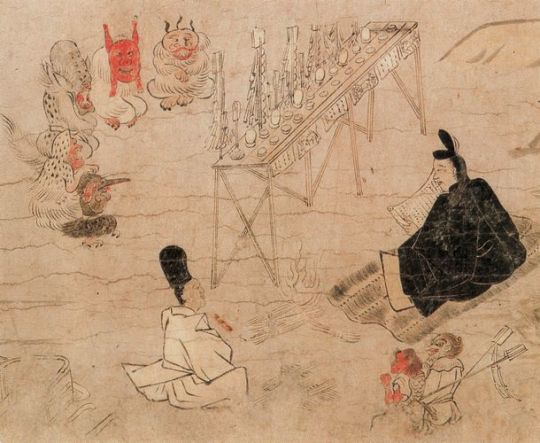
Abe no Seimei exorcising disease spirits (疫病神, yakubyōgami), as depicted in the Fudō Riyaku Engi Emaki. Two creatures who might be shikigami are visible in the bottom right corner (wikimedia commons; identification following Bernard Faure’s Rage and Ravage, pp. 57-58)
In popular culture, shikigami are basically synonymous with onmyōdō. Was this always the case, though? And what is a shikigami, anyway? These questions are surprisingly difficult to answer. I’ve been meaning to attempt to do so for a longer while, but other projects kept getting in the way. Under the cut, you will finally be able to learn all about this matter.
This isn’t just a shikigami article, though. Since historical context is a must, I also provide a brief history of onmyōdō and some of its luminaries. You will also learn if there were female onmyōji, when stars and time periods turn into deities, what onmyōdō has to do with a tale in which Zhong Kui became a king of a certain city in India - and more!
The early days of onmyōdō In order to at least attempt to explain what the term shikigami might have originally entailed, I first need to briefly summarize the history of onmyōdō (陰陽道). This term can be translated as “way of yin and yang”, and at the core it was a Japanese adaptation of the concepts of, well, yin and yang, as well as the five elements. They reached Japan through Daoist and Buddhist sources. Daoism itself never really became a distinct religion in Japan, but onmyōdō is arguably among the most widespread adaptations of its principles in Japanese context.
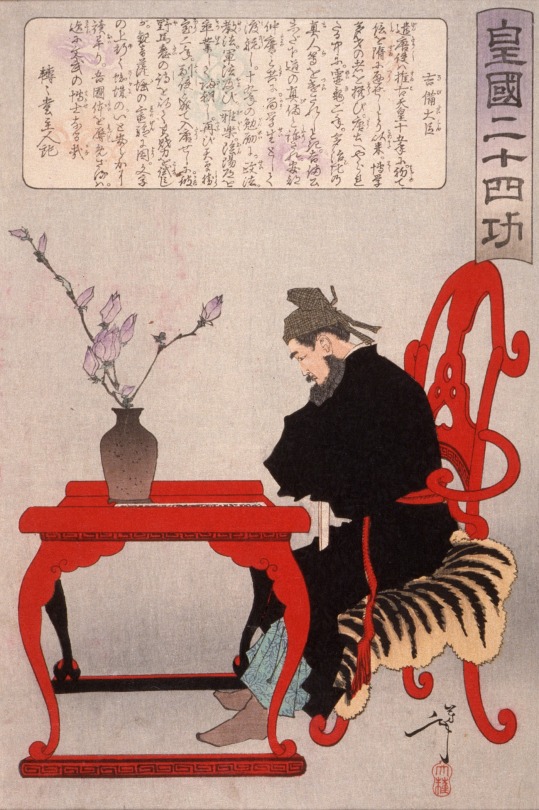
Kibi no Makibi, as depicted by Yoshitoshi Tsukioka (wikimedia commons)
It’s not possible to speak of a singular founder of onmyōdō comparable to the patriarchs of Buddhist schools. Bernard Faure notes that in legends the role is sometimes assigned to Kibi no Makibi, an eighth century official who spent around 20 years in China. While he did bring many astronomical treatises with him when he returned, this is ultimately just a legend which developed long after he passed away.
In reality onmyōdō developed gradually starting with the sixth century, when Chinese methods of divination and treatises dealing with these topics first reached Japan. Early on Buddhist monks from the Korean kingdom of Baekje were the main sources of this knowledge. We know for example that the Soga clan employed such a specialist, a certain Gwalleuk (観勒; alternatively known under the Japanese reading of his name, Kanroku).
Obviously, divination was viewed as a very serious affair, so the imperial court aimed to regulate the continental techniques in some way. This was accomplished by emperor Tenmu with the formation of the onmyōryō (陰陽寮), “bureau of yin and yang” as a part of the ritsuryō system of governance. Much like in China, the need to control divination was driven by the fears that otherwise it would be used to legitimize courtly intrigues against the emperor, rebellions and other disturbances. Officials taught and employed by onmyōryō were referred to as onmyōji (陰陽師). This term can be literally translated as “yin-yang master”. In the Nara period, they were understood essentially as a class of public servants. Their position didn’t substantially differ from that of other specialists from the onmyōryō: calendar makers, officials responsible for proper measurement of time and astrologers. The topics they dealt with evidently weren’t well known among commoners, and they were simply typical members of the literate administrative elite of their times.
Onmyōdō in the Heian period: magic, charisma and nobility
The role of onmyōji changed in the Heian period. They retained the position of official bureaucratic diviners in employ of the court, but they also acquired new duties. The distinction between them and other onmyōryō officials became blurred. Additionally their activity extended to what was collectively referred to as jujutsu (呪術), something like “magic” though this does not fully reflect the nuances of this term. They presided over rainmaking rituals, purification ceremonies, so-called “earth quelling”, and establishing complex networks of temporal and directional taboos.

A Muromachi period depiction of Abe no Seimei (wikimedia commons)
The most famous historical onmyōji like Kamo no Yasunori and his student Abe no Seimei were active at a time when this version of onmyōdō was a fully formed - though obviously still evolving - set of practices and beliefs. In a way they represented a new approach, though - one in which personal charisma seemed to matter just as much, if not more, than official position. This change was recognized as a breakthrough by at least some of their contemporaries. For example, according to the diary of Minamoto no Tsuneyori, the Sakeiki (左經記), “in Japan, the foundations of onmyōdō were laid by Yasunori”.
The changes in part reflected the fact that onmyōji started to be privately contracted for various reasons by aristocrats, in addition to serving the state. Shin’ichi Shigeta notes that it essentially turned them from civil servants into tradespeople. However, he stresses they cannot be considered clergymen: their position was more comparable to that of physicians, and there is no indication they viewed their activities as a distinct religion. Indeed, we know of multiple Heian onmyōji, like Koremune no Fumitaka or Kamo no Ieyoshi, who by their own admission were devout Buddhists who just happened to work as professional diviners.
Shin’ichi Shigeta notes is evidence that in addition to the official, state-sanctioned onmyōji, “unlicensed” onmyōji who acted and dressed like Buddhist clergy, hōshi onmyōji (法師陰陽師) existed. The best known example is Ashiya Dōman, a mainstay of Seimei legends, but others are mentioned in diaries, including the famous Pillow Book. It seems nobles particularly commonly employed them to curse rivals. This was a sphere official onmyōji abstained from due to legal regulations. Curses were effectively considered crimes, and government officials only performed apotropaic rituals meant to protect from them. The Heian period version of onmyōdō captivated the imagination of writers and artists, and its slightly exaggerated version present in classic literature like Konjaku Monogatari is essentially what modern portrayals in fiction tend to go back to.
Medieval onmyōdō: from abstract concepts to deities
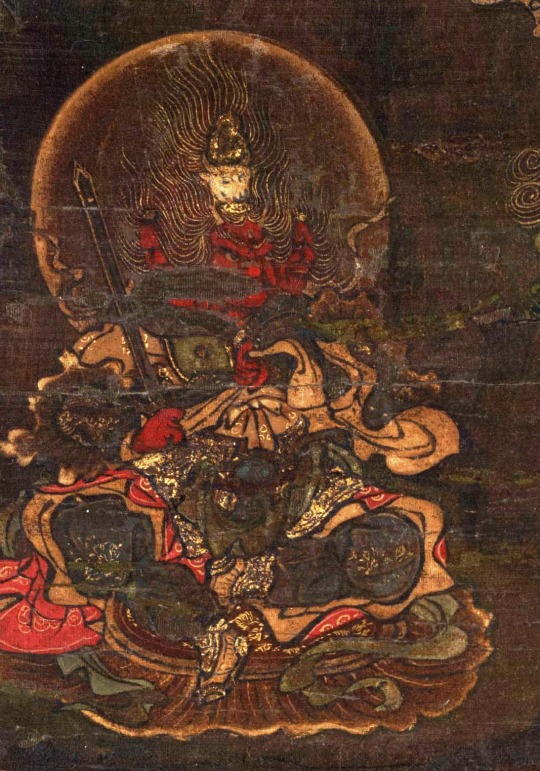
Gozu Tennō (wikimedia commons)
Further important developments occurred between the twelfth and fourteenth centuries. This period was the beginning of the Japanese “middle ages” which lasted all the way up to the establishment of the Tokugawa shogunate. The focus in onmyōdō in part shifted towards new, or at least reinvented, deities, such as calendarical spirits like Daishōgun (大将軍) and Ten’ichijin (天一神), personifications of astral bodies and concepts already crucial in earlier ceremonies. There was also an increased interest in Chinese cosmological figures like Pangu, reimagined in Japan as “king Banko”. However, the most famous example is arguably Gozu Tennō, who you might remember from my Susanoo article.
The changes in medieval onmyōdō can be described as a process of convergence with esoteric Buddhism. The points of connection were rituals focused on astral and underworld deities, such as Taizan Fukun or Shimei (Chinese Siming). Parallels can be drawn between this phenomenon and the intersection between esoteric Buddhism and some Daoist schools in Tang China. Early signs of the development of a direct connection between onmyōdō and Buddhism can already be found in sources from the Heian period, for example Kamo no Yasunori remarked that he and other onmyōji depend on the same sources to gain proper understanding of ceremonies focused on the Big Dipper as Shingon monks do.
Much of the information pertaining to the medieval form of onmyōdō is preserved in Hoki Naiden (ほき内伝; “Inner Tradition of the Square and the Round Offering Vessels”), a text which is part divination manual and part a collection of myths. According to tradition it was compiled by Abe no Seimei, though researchers generally date it to the fourteenth century. For what it’s worth, it does seem likely its author was a descendant of Seimei, though. Outside of specialized scholarship Hoki Naiden is fairly obscure today, but it’s worth noting that it was a major part of the popular perception of onmyōdō in the Edo period. A novel whose influence is still visible in the modern image of Seimei, Abe no Seimei Monogatari (安部晴明物語), essentially revolves around it, for instance.
Onmyōdō in the Edo period: occupational licensing
Novels aside, the first post-medieval major turning point for the history of onmyōdō was the recognition of the Tsuchimikado family as its official overseers in 1683. They were by no means new to the scene - onmyōji from this family already served the Ashikaga shoguns over 250 years earlier. On top of that, they were descendants of the earlier Abe family, the onmyōji par excellence. The change was not quite the Tsuchimikado’s rise, but rather the fact the government entrusted them with essentially regulating occupational licensing for all onmyōji, even those who in earlier periods existed outside of official administration.
As a result of the new policies, various freelance practitioners could, at least in theory, obtain a permit to perform the duties of an onmyōji. However, as the influence of the Tsuchimikado expanded, they also sought to oblige various specialists who would not be considered onmyōji otherwise to purchase licenses from them. Their aim was to essentially bring all forms of divination under their control. This extended to clergy like Buddhist monks, shugenja and shrine priests on one hand, and to various performers like members of kagura troupes on the other.
Makoto Hayashi points out that while throughout history onmyōji has conventionally been considered a male occupation, it was possible for women to obtain licenses from the Tsuchimikado. Furthermore, there was no distinct term for female onmyōji, in contrast with how female counterparts of Buddhist monks, shrine priests and shugenja were referred to with different terms and had distinct roles defined by their gender. As far as I know there’s no earlier evidence for female onmyōji, though, so it’s safe to say their emergence had a lot to do with the specifics of the new system. It seems the poems of the daughter of Kamo no Yasunori (her own name is unknown) indicate she was familiar with yin-yang theory or at least more broadly with Chinese philosophy, but that’s a topic for a separate article (stay tuned), and it's not quite the same, obviously.
The Tsuchimikado didn’t aim to create a specific ideology or systems of beliefs. Therefore, individual onmyōji - or, to be more accurate, individual people with onmyōji licenses - in theory could pursue new ideas. This in some cases lead to controversies: for instance, some of the people involved in the (in)famous 1827 Osaka trial of alleged Christians (whether this label really is applicable is a matter of heated debate) were officially licensed onmyōji. Some of them did indeed possess translated books written by Portuguese missionaries, which obviously reflected Catholic outlook. However, Bernard Faure suggests that some of the Edo period onmyōji might have pursued Portuguese sources not strictly because of an interest in Catholicism but simply to obtain another source of astronomical knowledge.
The legacy of onmyōdō
In the Meiji period, onmyōdō was banned alongside shugendō. While the latter tradition experienced a revival in the second half of the twentieth century, the former for the most part didn’t. However, that doesn’t mean the history of onmyōdō ends once and for all in the second half of the nineteenth century.
Even today in some parts of Japan there are local religious traditions which, while not identical with historical onmyōdō, retain a considerable degree of influence from it. An example often cited in scholarship is Izanagi-ryū (いざなぎ流) from the rural Monobe area in the Kōchi Prefecture. Mitsuki Ueno stresses that the occasional references to Izanagi-ryū as “modern onmyōdō” in literature from the 1990s and early 2000s are inaccurate, though. He points out they downplay the unique character of this tradition, and that it shows a variety of influences. Similar arguments have also been made regarding local traditions from the Chūgoku region.
Until relatively recently, in scholarship onmyōdō was basically ignored as superstition unworthy of serious inquiries. This changed in the final decades of the twentieth century, with growing focus on the Japanese middle ages among researchers. The first monographs on onmyōdō were published in the 1980s. While it’s not equally popular as a subject of research as esoteric Buddhism and shugendō, formerly neglected for similar reasons, it has nonetheless managed to become a mainstay of inquiries pertaining to the history of religion in Japan.
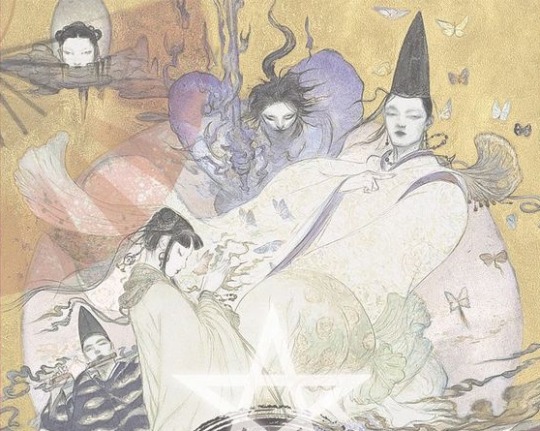
Yoshitaka Amano's illustration of Baku Yumemakura's fictionalized portrayal of Abe no Seimei (right) and other characters from his novels (reproduced here for educational purposes only)
Of course, it’s also impossible to talk about onmyōdō without mentioning the modern “onmyōdō boom”. Starting with the 1980s, onmyōdō once again became a relatively popular topic among writers. Novel series such as Baku Yumemakura’s Onmyōji, Hiroshi Aramata’s Teito Monogatari or Natsuhiko Kyōgoku’s Kyōgōkudō and their adaptations in other media once again popularized it among general audiences. Of course, since these are fantasy or mystery novels, their historical accuracy tends to vary (Yumemakura in particular is reasonably faithful to historical literature, though). Still, they have a lasting impact which would be impossible to accomplish with scholarship alone.
Shikigami: historical truth, historical fiction, or both?
You might have noticed that despite promising a history of shikigami, I haven’t used this term even once through the entire crash course in history of onmyōdō. This was a conscious choice. Shikigami do not appear in any onmyōdō texts, even though they are a mainstay of texts about onmyōdō, and especially of modern literature involving onmyōji.
It would be unfair to say shikigami and their prominence are merely a modern misconception, though. Virtually all of the famous legends about onmyōji feature shikigami, starting with the earliest examples from the eleventh century. Based on Konjaku Monogatari, there evidently was a fascination with shikigami at the time of its compilation. Fujiwara no Akihira in the Shinsarugakuki treats the control of shikigami as an essential skill of an onmyōji, alongside the abilities to “freely summon the twelve guardian deities, call thirty-six types of wild birds (...), create spells and talismans, open and close the eyes of kijin (鬼神; “demon gods”), and manipulate human souls”.
It is generally agreed that such accounts, even though they belong to the realm of literary fiction, can shed light on the nature and importance of shikigami. They ultimately reflect their historical context to some degree. Furthermore, it is not impossible that popular understanding of shikigami based on literary texts influenced genuine onmyōdō tradition. It’s worth pointing out that today legends about Abe no Seimei involving them are disseminated by two contemporary shrines dedicated to him, the Seimei Shrine (晴明神社) in Kyoto and the Abe no Seimei Shrine (安倍晴明神社) in Osaka. Interconnected networks of exchange between literature and religious practice are hardly a unique or modern phenomenon.
However, even with possible evidence from historical literature taken into account, it is not easy to define shikigami. The word itself can be written in three different ways: 式神 (or just 式), 識神 and 職神, with the first being the default option. The descriptions are even more varied, which understandably lead to the rise of numerous interpretations in modern scholarship. Carolyn Pang in her recent treatments of shikigami, which you can find in the bibliography, has recently divided them into five categories. I will follow her classification below.
Shikigami take 1: rikujin-shikisen

An example of shikiban, the divination board used in rikujin-shikisen (Museum of Kyoto, via onmarkproductions.com; reproduced here for educational purposes only)
A common view is that shikigami originate as a symbolic representation of the power of shikisen (式占) or more specifically rikujin-shikisen (六壬式占), the most common form of divination in onmyōdō. It developed from Chinese divination methods in the Nara period, and remained in the vogue all the way up to the sixteenth century, when it was replaced by ekisen (易占), a method derived from the Chinese Book of Changes.
Shikisen required a special divination board known as shikiban (式盤), which consists of a square base, the “earth panel” (地盤, jiban), and a rotating circle placed on top of it, the “heaven panel” (天盤, tenban). The former was marked with twelve points representing the signs of the zodiac and the latter with representations of the “twelve guardians of the months” (十二月将, jūni-gatsushō; their identity is not well defined). The heaven panel had to be rotated, and the diviner had to interpret what the resulting combination of symbols represents. Most commonly, it was treated as an indication whether an unusual phenomenon (怪/恠, ke) had positive or negative implications. It’s worth pointing out that in the middle ages the shikiban also came to be used in some esoteric Buddhist rituals, chiefly these focused on Dakiniten, Shōten and Nyoirin Kannon. However, they were only performed between the late Heian and Muromachi periods, and relatively little is known about them. In most cases the divination board was most likely modified to reference the appropriate esoteric deities.
Shikigami take 2: cognitive abilities
While the view that shikigami represented shikisen is strengthened by the fact both terms share the kanji 式, a variant writing, 識神, lead to the development of another proposal. Since the basic meaning of 識 is “consciousness”, it is sometimes argued that shikigami were originally an “anthropomorphic realization of the active psychological or mental state”, as Caroline Pang put it - essentially, a representation of the will of an onmyōji. Most of the potential evidence in this case comes from Buddhist texts, such as Bosatsushotaikyō (菩薩処胎経).
However, Bernard Faure assumes that the writing 識神 was a secondary reinterpretation, basically a wordplay based on homonymy. He points out the Buddhist sources treat this writing of shikigami as a synonym of kushōjin (倶生神). This term can be literally translated as “deities born at the same time”. Most commonly it designates a pair of minor deities who, as their name indicates, come into existence when a person is born, and then records their deeds through their entire life. Once the time for Enma’s judgment after death comes, they present him with their compiled records. It has been argued that they essentially function like a personification of conscience.
Shikigami take 3: energy
A further speculative interpretation of shikigami in scholarship is that this term was understood as a type of energy present in objects or living beings which onmyōji were believed to be capable of drawing out and harnessing to their ends. This could be an adaptation of the Daoist notion of qi (氣). If this definition is correct, pieces of paper or wooden instruments used in purification ceremonies might be examples of objects utilized to channel shikigami.
The interpretation of shikigami as a form of energy is possibly reflected in Konjaku Monogatari in the tale The Tutelage of Abe no Seimei under Tadayuki. It revolves around Abe no Seimei’s visit to the house of the Buddhist monk Kuwanten from Hirosawa. Another of his guests asks Seimei if he is capable of killing a person with his powers, and if he possesses shikigami. He affirms that this is possible, but makes it clear that it is not an easy task. Since the guests keep urging him to demonstrate nonetheless, he promptly demonstrates it using a blade of grass. Once it falls on a frog, the animal is instantly crushed to death. From the same tale we learn that Seimei’s control over shikigami also let him remotely close the doors and shutters in his house while nobody was inside.
Shikigami take 4: curse As I already mentioned, arts which can be broadly described as magic - like the already mentioned jujutsu or juhō (呪法, “magic rituals”) - were regarded as a core part of onmyōji’s repertoire from the Heian period onward. On top of that, the unlicensed onmyōji were almost exclusively associated with curses. Therefore, it probably won’t surprise you to learn that yet another theory suggests shikigami is simply a term for spells, curses or both. A possible example can be found in Konjaku Monogatari, in the tale Seimei sealing the young Archivist Minor Captains curse - the eponymous curse, which Seimei overcomes with protective rituals, is described as a shikigami.

Kunisuda Utagawa's illustration of an actor portraying Dōman in a kabuki play (wikimedia commons)
Similarities between certain descriptions of shikigami and practices such as fuko (巫蠱) and goraihō (五雷法) have been pointed out. Both of these originate in China. Fuko is the use of poisonous, venomous or otherwise negatively perceived animals to create curses, typically by putting them in jars, while goraihō is the Japanese version of Daoist spells meant to control supernatural beings, typically ghosts or foxes. It’s worth noting that a legend according to which Dōman cursed Fujiwara no Michinaga on behalf of lord Horikawa (Fujiwara no Akimitsu) involves him placing the curse - which is itself not described in detail - inside a jar.
Mitsuki Ueno notes that in the Kōchi Prefecture the phrase shiki wo utsu, “to strike with a shiki”, is still used to refer to cursing someone. However, shiki does not necessarily refer to shikigami in this context, but rather to a related but distinct concept - more on that later.
Shikigami take 5: supernatural being
While all four definitions I went through have their proponents, yet another option is by far the most common - the notion of shikigami being supernatural beings controlled by an onmyōji. This is essentially the standard understanding of the term today among general audiences. Sometimes attempts are made to identify it with a specific category of supernatural beings, like spirits (精霊, seirei), kijin or lesser deities (下級神, kakyū shin). However, none of these gained universal support. Generally speaking, there is no strong indication that shikigami were necessarily imagined as individualized beings with distinct traits.
The notion of shikigami being supernatural beings is not just a modern interpretation, though, for the sake of clarity. An early example where the term is unambiguously used this way is a tale from Ōkagami in which Seimei sends a nondescript shikigami to gather information. The entity, who is not described in detail, possesses supernatural skills, but simultaneously still needs to open doors and physically travel.
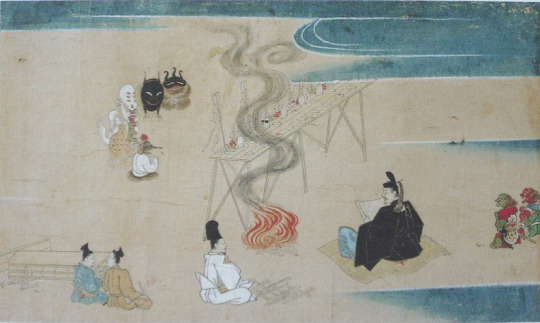
An illustration from Nakifudō Engi Emaki (wikimedia commons)
In Genpei Jōsuiki there is a reference to Seimei’s shikigami having a terrifying appearance which unnerved his wife so much he had to order the entities to hide under a bride instead of residing in his house. Carolyn Pang suggests that this reflects the demon-like depictions from works such as Abe no Seimei-kō Gazō (安倍晴明公画像; you can see it in the Heian section), Fudōriyaku Engi Emaki and Nakifudō Engi Emaki.
Shikigami and related concepts

A gohō dōji, as depicted in the Shigisan Engi Emaki (wikimedia commons)
The understanding of shikigami as a “spirit servant” of sorts can be compared with the Buddhist concept of minor protective deities, gohō dōji (護法童子; literally “dharma-protecting lads”). These in turn were just one example of the broad category of gohō (護法), which could be applied to virtually any deity with protective qualities, like the historical Buddha’s defender Vajrapāṇi or the Four Heavenly Kings. A notable difference between shikigami and gohō is the fact that the former generally required active summoning - through chanting spells and using mudras - while the latter manifested on their own in order to protect the pious. Granted, there are exceptions. There is a well attested legend according to which Abe no Seimei’s shikigami continued to protect his residence on own accord even after he passed away. Shikigami acting on their own are also mentioned in Zoku Kojidan (続古事談). It attributes the political downfall of Minamoto no Takaakira (源高明; 914–98) to his encounter with two shikigami who were left behind after the onmyōji who originally summoned them forgot about them.
A degree of overlap between various classes of supernatural helpers is evident in texts which refer to specific Buddhist figures as shikigami. I already brought up the case of the kushōjin earlier. Another good example is the Tendai monk Kōshū’s (光宗; 1276–1350) description of Oto Gohō (乙護法). He is “a shikigami that follows us like the shadow follows the body. Day or night, he never withdraws; he is the shikigami that protects us” (translation by Bernard Faure). This description is essentially a reversal of the relatively common title “demon who constantly follow beings” (常随魔, jōzuima). It was applied to figures such as Kōjin, Shōten or Matarajin, who were constantly waiting for a chance to obstruct rebirth in a pure land if not placated properly.

The Twelve Heavenly Generals (Tokyo National Museum, via wikimedia commons)
A well attested group of gohō, the Twelve Heavenly Generals (十二神将, jūni shinshō), and especially their leader Konpira (who you might remember from my previous article), could be labeled as shikigami. However, Fujiwara no Akihira’s description of onmyōji skills evidently presents them as two distinct classes of beings.
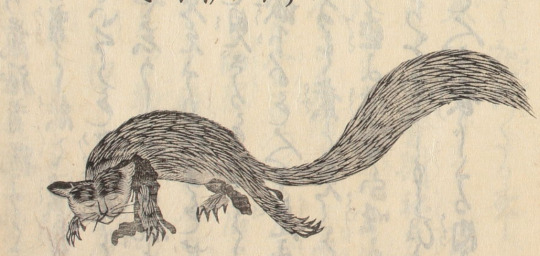
A kuda-gitsune, as depicted in Shōzan Chomon Kishū by Miyoshi Shōzan (Waseda University History Museum; reproduced here for educational purposes only)
Granted, Akihira also makes it clear that controlling shikigami and animals are two separate skills. Meanwhile, there is evidence that in some cases animal familiars, especially kuda-gitsune used by iizuna (a term referring to shugenja associated with the cult of, nomen omen, Iizuna Gongen, though more broadly also something along the lines of “sorcerer”), were perceived as shikigami.
Beliefs pertaining to gohō dōji and shikigami seemingly merged in Izanagi-ryū, which lead to the rise of the notion of shikiōji (式王子; ōji, literally “prince”, can be another term for gohō dōji). This term refers to supernatural beings summoned by a ritual specialist (祈祷師, kitōshi) using a special formula from doctrinal texts (法文, hōmon). They can fulfill various functions, though most commonly they are invoked to protect a person, to remove supernatural sources of diseases, to counter the influence of another shikiōji or in relation to curses.
Tenkeisei, the god of shikigami
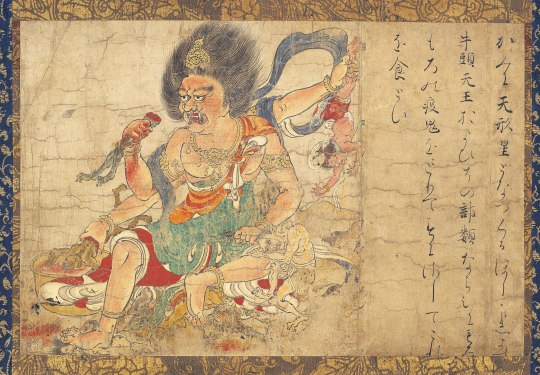
Tenkeisei (wikimedia commons)
The final matter which warrants some discussion is the unusual tradition regarding the origin of shikigami which revolves around a deity associated with this concept.
In the middle ages, a belief that there were exactly eighty four thousand shikigami developed. Their source was the god Tenkeisei (天刑星; also known as Tengyōshō). His name is the Japanese reading of Chinese Tianxingxing. It can be translated as “star of heavenly punishment”. This name fairly accurately explains his character. He was regarded as one of the so-called “baleful stars” (凶星, xiong xing) capable of controlling destiny. The “punishment” his name refers to is his treatment of disease demons (疫鬼, ekiki). However, he could punish humans too if not worshiped properly.
Today Tenkeisei is best known as one of the deities depicted in a series of paintings known as Extermination of Evil, dated to the end of the twelfth century. He has the appearance of a fairly standard multi-armed Buddhist deity. The anonymous painter added a darkly humorous touch by depicting him right as he dips one of the defeated demons in vinegar before eating him. Curiously, his adversaries are said to be Gozu Tennō and his retinue in the accompanying text. This, as you will quickly learn, is a rather unusual portrayal of the relationship between these two deities.
I’m actually not aware of any other depictions of Tenkeisei than the painting you can see above. Katja Triplett notes that onmyōdō rituals associated with him were likely surrounded by an aura of secrecy, and as a result most depictions of him were likely lost or destroyed. At the same time, it seems Tenkeisei enjoyed considerable popularity through the Kamakura period. This is not actually paradoxical when you take the historical context into account: as I outlined in my recent Amaterasu article, certain categories of knowledge were labeled as secret not to make their dissemination forbidden, but to imbue them with more meaning and value.
Numerous talismans inscribed with Tenkeisei’s name are known. Furthermore, manuals of rituals focused on him have been discovered. The best known of them, Tenkeisei-hō (天刑星法; “Tenkeisei rituals”), focuses on an abisha (阿尾捨, from Sanskrit āveśa), a ritual involving possession by the invoked deity. According to a legend was transmitted by Kibi no Makibi and Kamo no Yasunori. The historicity of this claim is doubtful, though: the legend has Kamo no Yasunori visit China, which he never did. Most likely mentioning him and Makibi was just a way to provide the text with additional legitimacy.
Other examples of similar Tenkeisei manuals include Tenkeisei Gyōhō (天刑星行法; “Methods of Tenkeisei Practice”) and Tenkeisei Gyōhō Shidai (天刑星行法次第; “Methods of Procedure for the Tenkeisei Practice”). Copies of these texts have been preserved in the Shingon temple Kōzan-ji.
The Hoki Naiden also mentions Tenkeisei. It equates him with Gozu Tennō, and explains both of these names refer to the same deity, Shōki (商貴), respectively in heaven and on earth. While Shōki is an adaptation of the famous Zhong Kui, it needs to be pointed out that here he is described not as a Tang period physician but as an ancient king of Rajgir in India. Furthermore, he is a yaksha, not a human. This fairly unique reinterpretation is also known from the historical treatise Genkō Shakusho. Post scriptum The goal of this article was never to define shikigami. In the light of modern scholarship, it’s basically impossible to provide a single definition in the first place. My aim was different: to illustrate that context is vital when it comes to understanding obscure historical terms. Through history, shikigami evidently meant slightly different things to different people, as reflected in literature. However, this meaning was nonetheless consistently rooted in the evolving perception of onmyōdō - and its internal changes. In other words, it reflected a world which was fundamentally alive. The popular image of Japanese culture and religion is often that of an artificial, unchanging landscape straight from the “age of the gods”, largely invented in the nineteenth century or later to further less than noble goals. The case of shikigami proves it doesn’t need to be, though. The malleable, ever-changing image of shikigami, which remained a subject of popular speculation for centuries before reemerging in a similar role in modern times, proves that the more complex reality isn’t necessarily any less interesting to new audiences.
Bibliography
Bernard Faure, A Religion in Search of a Founder?
Idem, Rage and Ravage (Gods of Medieval Japan vol. 3)
Makoto Hayashi, The Female Christian Yin-Yang Master
Jun’ichi Koike, Onmyōdō and Folkloric Culture: Three Perspectives for the Development of Research
Irene H. Lin, Child Guardian Spirits (Gohō Dōji) in the Medieval Japanese Imaginaire
Yoshifumi Nishioka, Aspects of Shikiban-Based Mikkyō Rituals
Herman Ooms, Yin-Yang's Changing Clientele, 600-800 (note there is n apparent mistake in one of the footnotes, I'm pretty sure the author wanted to write Mesopotamian astronomy originated 4000 years ago, not 4 millenia BCE as he did; the latter date makes little sense)
Carolyn Pang, Spirit Servant: Narratives of Shikigami and Onmyōdō Developments
Idem, Uncovering Shikigami. The Search for the Spirit Servant of Onmyōdō
Shin’ichi Shigeta, Onmyōdō and the Aristocratic Culture of Everyday Life in Heian Japan
Idem, A Portrait of Abe no Seimei
Katja Triplett, Putting a Face on the Pathogen and Its Nemesis. Images of Tenkeisei and Gozutennō, Epidemic-Related Demons and Gods in Medieval Japan
Mitsuki Umeno, The Origins of the Izanagi-ryū Ritual Techniques: On the Basis of the Izanagi saimon
Katsuaki Yamashita, The Characteristics of On'yōdō and Related Texts
161 notes
·
View notes
Text
haruka and what each animal on his case represents, an analysis
before we begin, general CW for the issues haruka's story deals with (neglect, child abuse, animal death, etc).

Throughout the MVs, animals play an important role in Haruka's story. I think each of these represents a part of Haruka, both how he perceives himself and how he wants to be perceived. Even if Haruka presumably has numerous animal victims, the ones most emphasized are dogs, fish, and rabbits.
1. RABBITS

Haruka is seen on many occasions with his bunny plush. It’s so important that it appears not only in Weakness and Undercover but also in graffart’s collab, where each item is importan on the character's story in one way or another (like mahiru and the mantis). I see it as a toy from his childhood that he’s very attached to.
The fact that it’s specifically a rabbit is interesting to me, as the rabbit is a prey. If we go to the unique point of view of Japanese culture, rabbits are also quite related to the moon. The lunar cycles are also an important symbol in weakness, showing white, blue and finally red moons over a red sky. The origin of the relationship between rabbits and the moon is debated between admiration as they are perceived as objects of fertility and health because of their reproduction, or a legend that spread from India:
"a rabbit can't tolerate seeing people die and jumps into the fire to become food, then Indra rewards him for his sacrifice and takes him to the moon."
The theme of self sacrifice and the ultimate reward one receives for it is reinforced by Taoism, where the hare, like the moon, dies to be reborn and represents immortality. More popularly, rabbits are also associated with good fortune. It being white also points to innocence, and in turn to the pursuit of something that upon attainment brings discovery, an idea popularized by Alice in Wonderland. Even if it's more seen as a weak and tender animal, it has also been culturally represented as cruel and capable of aggression, closer to what Haruka is than the role of merely a prey. Haruka wants to be seen as weak prey that the strong hunt, to be pitied and loved for it. To be perceived as someone to be protected, as he cannot defend himself, but this is contradicted by his own actions both in weakness and throughout milgram. The prey becomes the predator and gives way to the next animal;
2. DOGS

The dog is universally a symbol of loyalty and the effort it takes to form a training bond between a wild animal and a human. Dogs are seen accompanying men and being obedient to women.
Dogs are perceived as creatures that love unconditionally and are capable of giving everything to protect those they love.

In terms of personality and behavior, they are the closest animals to Haruka, who accepts and actively seeks to be guided and to be faithful for someone, to be used to feel useful and not abandoned.

Even if they are domestic, the dogs whose breeds are distinguishable are large dogs, considered to be hunting dogs. Haruka being represented as a dog also creates a parallel with kotoko, who is represented by a wolf.
Haruka being represented as a dog also creates a parallel with kotoko, who is represented by a wolf. Dogs are the friendlier, "clean" version of wolves, domesticated to be obedient, while wolves maintain a certain solitary air of independence and savagery.
However, whenever a dog is featured on screen it is accompanied by loud instrumentals and rather graphic visuals. In Weakness, child Haruka accepts and expresses affection towards the animal, who apparently is suddenly injured and runs away from him into a forest, where he is disoriented and confused. Haruka follows its footsteps and ends up seeing his hands in horror, realizing that he's the cause of its injury.
The perspective of present Haruka isn't so different, who now attacks it, destroying it until the only remains are the necklace it was wearing, ultramarine liquid and eyes, which I consider represent the opinions of others and looks that judge him.

I think the fact that this dog bleeds the same color as Haruka's is a not-so-hidden hint at the fact that, in a way, Haruka is ending up with a part of himself (this time a bit smaller, not being human yet) to escape people's judgments.
There are also many sayings that by mistreating someone, "you are treating them like a dog", like an animal, something inferior, but that still sticks to what the human wants and believing all their words.
In AKAA, we see that instead of being a mix of at least two dogs, they're now separate entities and different breeds that dissolve as Haruka sings about being reborn. Again, dogs often appear in stories as spirit guides, helping humans enter and exit the realm of the dead safely, representing a middle ground between life and death. Dogs are followers of their owners, not leaders, and no matter how close a bond they form with humans, they are rarely recognized as equals to us.
3. FISH

Most of the similarities between Haruka and fish are presented visually, with Haruka being a passive spectator of his own life, observing others from behind something akin to a glass wall that separates him from normal people. He's constantly surrounded by water drowning, and in one scene is even presented at a fish-eye angle, being watched by his mother.
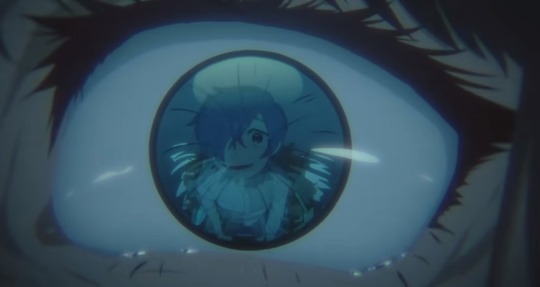
In AKAA we can see two specific species of fish.

Yellow bobfish: they're very complicated fish to keep in aquariums because they release toxins when stressed and are naturally solitary once they reach adulthood, it's not recommended to have more than two in the same tank because they are territorial and aggressive among their own species, however it's friendly and sociable with fish of other species. It responds to stress with aggression and attacks its own kind (in this case other weaklings) just like Haruka.

Clownfish: they usually inhabit anemones, forming a mutualism in which they find shelter and food. Toxins from anemones don't affect them as they develop immunity to them throughout their lives to eventually live in them. Anemones benefit from clownfishes cleaning its tentacles. Clownfish often eat parasites and are also known to steal more food from anemones than what they give in return. They are also capable of changing sex from male to female. Seeing this particular species depicted tells us a lot not only about haruka, but about his relationship with Muu, as for the first time it's not depicted as a mutual need, a codependency that endangers their lives if they become separated, but a mutually beneficial relationship where both can exist separately, but live much more comfortably by relating to each other in this way.
Extra: Insects (specifically butterflies) and parasites.
The symbolism of transformation and metamorphosis is so present that it even took the title of both voice dramas. Caterpillars can only wriggle and are no different from any worthless worm, but after a season, they manage to transform into a butterfly: beautiful, admirable, much more memorable and lovable. Having been forgiven and meeting Muu, Haruka manages to "fulfill" his metamorphosis and become someone he believes is better. Still, from what is shown in AKAA, it doesn't seem that Haruka is entirely happy with this change happening - the monarch butterflies represents ambition and perseverance, but it seems to be rejected by haruka, who crushes it in his hands


Haruka longs for this transformation, but is unable to fully accept it happening. I think it's because no matter how much he changes and wants to be someone else, he can't get rid of the disastrous image he has of himself, or he has forced himself not to change so as not to be disliked even more by others.
Now, Kotoko is an important figure to Haruka despite not interacting much. It highlights both his codependency (or mutually beneficial relationship) with Muu as much as the fact that he assimilates a parasite.

This is a point I've made several times before, but Haruka's way of socializing is based on taking parts of others and melding them on himself, especially women. It started by stealing his mother's necklace and taking it as his own, continues by killing Mirai and stealing what he lacks, and ends now in a much more obvious way with Muu, imitating her personality, accepting her accessories and the clothes she chooses for him and even copying her sprite pose a bit.


If he had become closer to Yuno and Mahiru, I'm sure he would also start imitating their behaviors in one way or another. Haruka lives by taking parts of the women he surrounds herself with, and he seems to want to take something from kotoko as well, but it's still unclear what he wants.
What does all of this have in common?
Not only is the theme of change and rebirth prominent, but every animal that Haruka comes to hurt relates in one way or another to his desires, thoughts, or parts of himself. Figuratively, we can say that Haruka's case is about him eliminating and hiding every part of himself, until he murders his human victim, Mirai, who at the same time is the closest and most prominent part in him, with whom he wishes he could reconcile and exist together, accepting each other - for, unlike his other victims, Mirai is often presented as a friend and someone Haruka misses. I have yet to write Mirai's analysis on its own, so whether she is also a part of Haruka or not and whether all his kills are figurative is up to each one's choice, I tend to wander between both sides because I like both scenarios. In a less figurative way and taking the case more literally, these facts are simple trivia and interesting symbolism to consider when analyzing Haruka.
#milgram#haruka sakurai#milgram analysis#Weakness analysis#Akaa analysis#Analysis#I'm **SHAKING** DO WE ALL SEE ALL OF THESE HARUKA AS QUEER - GNC - MTF HINTS???#I HOEP WE ALL DO!!#Twt moot infected me with the haruka MTF disease and now I see it everywhere#There are a lot of queer motifs on haruka's story it drives me actually insane. It's so visceral#Anyways I hope you guys like this#It's been a lot since ive last posted an analysis and I really wanted to talk about this#I also want to write something specifically about Mirai and all of the possible interpretations she could have inside haruka's story#Both as a real person and an ideal concept
119 notes
·
View notes
Note
I’ve heard comparisons to various kinds of regimes that we could expect of the upcoming shitstorm. Do we have any idea of which one is most likely? I’ve heard everything from India to Franco’s Spain…
I mean to be clear I have no idea, no inside track, just kinda a gut feeling?
I think we have a range from Netanyahu to Putin on the illiberal "Democracy" scale, I hope we land on Netanyahu where elections are still possible and unseating him is hard but doable. In a Netanyahu like scenario the illiberal leader floods the zone with propaganda, radicalizes his supporters, attacks free media and demonizes political opponents as dangerous to the nation. But elections themselves remain free and fair its just the public discourse thats been corrupted and the leader is very comfortable doing give aways to key supporting blocks to win votes, national consequences be damned.
this clearly is very bad, and like Netanyahu you can expect Trump to attack our system of Justice and undermine its independence and try to destroy its powers all in the name of protecting himself. Hopefully however Trump's attacks will be narrowly focused on himself and not end up destroying much of our justice system.
I fear however we might end up with an Orbán or Erdoğan type system, where the above holds with the corruptions of media, the radicalization and radical polarization of society and the corruption of government to the sole end of the re-election of the leader and his party. But on top of that, elections are no longer free. I fear less a top down banning of elections, that remains very unlikely. I fear more local Republicans. I suspect no matter what they'll keep doing what they're doing, which is underfunding elections so major urban areas don't have enough polling places and suffer long lines and lower turn out, as well as passing more annoying and difficult voter ID laws designed to lower turnout particularly among black voters.
but I worry that with a Trump heavy judiciary more of these laws will get through and be MORE restrictive. I also fear we could see local Republican elected officials now empowered, will refuse to certify elections they dislike, or actively cheat and with a Trump controlled DOJ cases just are never brought, while local Democratic officials might live under a microscope and be charged and removed for literally any imaginary thing. Indeed we saw Ron DeSantis removed a number of local legal officials who were popularly elected because he didn't like how they did their jobs. We could see a lot more of that in general but aimed at local Democratic elections officials in red/swing states.
in that case it goes from past hard to nearly impossible to remove the illiberal leader.
so basically we have to hope he just/only makes our society a toxic hate filled hell pit and the corruption of our Democracy remains minimal
41 notes
·
View notes
Text
we were studying about schizotypal personality disorder, and it's so weird, cuz they went "If you like spending time alone you have this" "if your ideas are different from others you have this" like, BE SO FOR REAL RIGHT NOW. It's literally a big money making pharmaceutical thingy and nobody can convince me otherwise. This is how they create this herd mentality, and I hate how nobody questions it, like nobody finds it weird?? It's literally not a disorder. There are a lot of mental disorders but this is not it, atp, they're just creating new things that don't even exist. Create new things, diagnose people with it and give them placebo medicines, great idea, isn't it?
I honestly hate hate hate how people don't use their brains, like if allopathy was so advanced and so great then why haven't they managed to find a cure for endometriosis. why have they not been able to create a birth control without side effects. why is it that they haven't been able to find a cure for thyroid? they give you a medicine for it and then you just have to keep on taking it for your entire life or they recommend removing your thyroid. why is it that their every solution consists of taking out the body part that has the problem instead of healing it??
It's annoying how people just believe stuff without ever questioning it. There are so many disorders that aren't even disorders. so many women are diagnosed with BPD despite them not actually having it. I do believe in vaccinations, and autism and adhd but I also don't believe in a lot of other stuff, it really doesn't make sense to me. I know so many girls who have such severe period pains despite not having pcos or endometriosis and the doctors just go "oh well, it's normal", like no the fuck, it's not. You shouldn't be having period cramps to the point where you are unable to do daily activities, and the fact that doctors just normalize it is absolutely baffling to me. the worst part is that the girls don't seem to give a shit about their body either, like, they have period pains and immediately swallow a BC pill, like your body is trying to tell you something, the severe cramps are an indication of a more serious underlying issue and you're just suppressing it. I started the discussion from god knows where, I don't even know how I reached this point, I'm just so pissed about everything. Also, stop taking Birth control as a method of contraception. They stop ovulation in a lot of cases, it's a very important process of the female body, stopping it is literally not healthy, GOSH. if your man refuses to wear condoms, throw the whole fucking man away, he doesn't care about you. there are many condoms made of good material that do not cause itching in the vagina, and lastly please educate yourselves. I'm not telling you to learn everything from google but rather telling you to study traditional medicine, I studied ayurveda and chinese medicine and have been able to solve every problem with it. You can believe me or choose not to, It's not like I can force somebody to do something, give it a try atleast. it will take longer to solve the problem, but that's because it actually "heals" instead of numbing the pain, and healing always takes time. Other than that..........what can I say.
my anger has subsided, reading this dsm pisses me off so much. almost all the disorders are most likely to be more common in women, I seriously wonder why..............Homosexuality was categorised as a mental health disorder once......lobotomy was considered to be normal......these fuckers also used to think that babies couldn't feel pain, so they used to perform surgeries without Anesthesia on them........this kind of thing never happened in ancient india........I refuse to believe anything that these idiots say
It's a "pseudoscience" ofc it is, anything that provides a solution and doesn't require a person to become a life long patient so you can extort money from them is a pseudoscience, dickheads.
27 notes
·
View notes
Text
Booker Prize-winning Indian author Arundhati Roy could be prosecuted for allegedly seditious comments made over a decade ago, after a top official in Delhi said there was enough evidence to lay charges.
Roy rose to international prominence for her novels, including 1997 Booker Prize winner “The God of Small Things,” but has also published two collections of political writing andlongbeen an outspoken critic of Indian Prime Minister Narendra Modi.[...]
Earlier this month, police in New Delhi raided the homes of prominent journalists linked to a left-leaning news organization known for its scrutiny of the Indian government. Police said they had arrested the outlet’s editor and a colleague as part of an ongoing investigation in connection with India’s Unlawful Activities (Prevention) Act, or UAPA, an anti-terror law that critics describe as “draconian.”[...]
The case was filed in 2010 over comments Roy made at a conference on Kashmir called “Azadi – the Only Way Ahead” – “azadi” means freedom or liberation and is often used as a slogan for the Kashmiri independence movement.[...]
In her 2010 speech,posted online, Roy spoke about Kashmiri efforts to seek justice, in part for the mass exodus of Hindus from Muslim-majority Kashmir in the early 1990s amid increasing violence.
12 Oct 23
213 notes
·
View notes
Text
I've been kind of in a IPK hateration mood lately (so if you're not in the mood for that look away lol) and its irritating that a lot of people find Khushi really annoying (which admittedly - she can be extremely trying, its kind of a core characteristic) for the same things they find extremely attractive and/or forgivable in Arnav. Such as arrogance, stubborness, narrow minded-ness, etc etc.
Personally to me, rewatching this show as a well grown adult (for the millionth time but thats not relevant 👀), Arnav can be extremely annoying. And immature too. And he's got flaws and made mistakes the size of Jupiter and not everything is to do with his deep dark past and lack of trust and misunderstandings.
Arnav calling the Gupta house ghatiya and his crappy behaviour leading up to that, for example, is to me one of his lowest moments but also an extremely real one which is perhaps why I have the most viscerally annoyed by it reaction. I am yet to meet someone who forced a girl into a contract marriage for 6 months to save their sister so its hard to take that one personally lol. But I do know about how casually violent classist dynamics can be especially in conservative families where the boy's side is richer than the girl's side. I've seen that exact anxious Gupta family - entitled damadji dynamic first hand. Yeah, this is how rich assholes in India behave and think. There isn't the slightest bit of gratitude or humility for the lottery they won in being one of the 1% of India, instead there is tremendous entitlement to every bit of power they wield combined with a barely concealed disgust/dehumanization of poor people. Unfortunately, best case scenario is actually someone like Arnav - not actively malicious or hostile but passively smugly superior towards anyone not of his "class", careless with his words and actions which often land as loaded weapons, and perfectly comfortable with using his money and power to control the lives of anyone dependent on him.
The ghatiya incident of course was followed by a contrition period of sorts which I do enjoy watching in isolation. But it means nothing really when you remember that well after misunderstandings are cleared, Arnav chose to financially blackmail Khushi with the threat of turning her poor parents out to the streets. That well after love declarations and marriage vows, Arnav in order to win an argument still mocked Khushi's financial status, reminded her of her financial dependency on him and insisted that all financial decisions should be taken by him.
There's a strong strain of classism in the way he thinks, in the language he uses, the numerous uses of the word "aukaad" - anyone who has spent any amount of time in Delhi knows the exact kind of person who frequently throws around the word aukaad. And frankly...its a toss up to me whats more annoying between Arnav's frequent and casual classism and Khushi's frequent and casual violation of people's boundaries.
(Except maybe that Arnav's is more annoying given that, you know, he gets the to tap into the power of oppressive structures of society to enforce all of his annoying habits while Khushi is just like, one annoying girl who often hurts people due to her interfering nature. The person I would consider the biggest victim of Khushi's annoying habits is actually Lavanya. Not Arnav.)
27 notes
·
View notes
Text
You ship the two dudes from RRR so you watched more Tollywood movies to see if there was anymore Fruity love stories but were disappointed finding out Tollywood actively stays always from Gay. Don’t worry I got you
So after Western audiences and he’ll even some brown people watched RRR They began to heavily ship Ram and Bheem.
I mean I get it two dudes back in like the 19th century India on rival sides of an internalized War becoming friends by chance and giving up their believes for said friendship to save said person from their ultimate demise while looking incredibly badass while doing it definitely gives some signals.
Sorry to disappoint though Rajamouli actually denied making Ram and Bheem canonly fruity and established hetero love stories for them due to the fact Most of Tollywood has little to never actively shown fruity characters sometimes making fun of them (transgenders we’re usually used to highlight ‘bad’ beauty in musical numbers dancing around the hero only to accentuate the beauty of the heroine). So for his own protection and to make sure RRR wouldn't flop Rajamouli forced Ram and Bheem to have Jenny and Sita as love interests kinda like the meme 'born to repost, forced to private'.
Some movies in Tollywood don’t actively hate on it though and yes use it as a laughing gag but then again Westerners often use the expression “Yes Queen” and that’s what I’d typically reference these gags to.
However I was rewatching some movies of a Tollywood actor named Ram Pothineni whose movies I grew up watching and still watch. One of my favorites is “Endukante Premanta” because it’s a reincarnation love story and I love reincarnation love stories plus it takes place on Paris something I realized years later.
Anyway so Ram Pothineni in 2013 starred in a movie named “Masala” along with another Popular actor from more older times like early 2000s and a bit before his name is Venkatesh Dagguabti.
So basically the movie itself is average you’d get it more if you were brought up in Tollywood Cinema like me.
The basic plot line is there’s the Muslim guy named Rehman who wants to get his sister married as his brotherly duty towards her however the face problems in a court case where their house is seized so their uncle transfers them to the village where their uncle lives and helps Rehman find work.
When Rehman arrives at this village an incident occurs where a little boy was climbing a stone gate to a building to get his Kite and accidentally falls on the other side of the Gate into the water. Past the Gate is a Temple that is closed off due to Legal Problems. Seeing the boy is drowning in the water Rehman smashed the lock to the gate and baits the door open diving into the water saving the boy. He gets in trouble with a few of the residents who are mad at him for breaking the gate open since the Temple being closed was a major issue in the village. However Balaram a very respected figure in the village intervenes supporting Rehman for his efforts in saving the kid Balaram was actually involved with the Temple closing incident with the Antagonist of the film his cousin who is intent on marrying Balaram’s sister which Balaram dislikes. After this incident Balaram decides to take the temple into his custody again thanks to Rehman’s effort with the support of the village people.
A thing you should know about Balaram is that he doesn’t tolerate Lies at all he’s a very good man helping everyone in the village at their time of need but no matter how big or small the lie is he will punish the other party for their lie. When Balaram asks Rehman for his name Rehman’s friend Siri lies telling him that it’s Ram a traditional Hindu name fearing that if the village people were to find out that it was because of Rehman a Muslim guy the Hindu temple reopened there would be problems since Islam and Hinduism are opposing faiths and even though they can tolerate the other faiths some people might not feel that way since it still is a sensitive topic.
Because of that one lie Rehman is forced to enter a rabbit hole of lies hiding his Muslim identity pretending his mother who died when he was young is still alive and that he’s a singing teacher in order to make sure Balaram won’t get suspicious of his lying.
Now the main point is Rehman in this movie for one of his lies is forced to pretend he has a younger Muslim stepbrother that looks just like him because Balaram’s advisor and him saw Rehman at a Mosque. Rehman’s fake younger brother character who he acts is a dancer by profession and is gay. Yep that’s the laughing gag.
However in the movie Rehman’s fruity character in my opinion isn’t really disrespectful at All There’s not really any homophobia to the character and he acts like any fruity man you’d see on TikTok with “Slay Queen” and “Yes Girly Pop” which is kinda translated into Telugu. He acts very fruity in his role which is like he’s supposed to because his Make believe younger brother is fruity. Rehman has Balaram’s men (his workers) actively questioning their sexuality with Rehman’s provacative actions in the movie. Sure Rehman is only pretending and hits them when they get too close and the workers take no for an answer (another victory if you see the earlier Telugu films at the time). Balaram hires fake Gay Rehman as a dance teacher for his younger sister since he doesn’t trust normal men around her since his cousin wants to marry her and has tried kidnapping her on multiple occasions. Balaram trusts ‘Rehman’ since he’s Gay though.
The actual Rehman ends up with the heroine in this case Balaram’s sister Meenakshi at the end of the movie revaluing his lies and being forgives but I fully believe Rehman was Bi in this movie. How he acted even when he wasn’t playing his fake character of his younger Gay brother was kind of fruity his voice alone will sometimes give you like James Charles kinda voice if you get what I mean.
I mean it’s not perfect in representation it’s still a Tollywood movie from the 2010s too but it is really progressive compared to the other movies and I found Tehman’s character when he was acting fruity or just pretending to be Ram or just his normal self was really funny.
see if you want to see another possibility of LGBTQ in Tollywood cinema you can watch This. I’m pretty sure you can watch the subtitle version on Einthusan.
#tollywood#ram pothineni#indian cinema#lgbtq community#indian lgbt#Masala Telugu movie#RRR#movie recommendation
34 notes
·
View notes
Text
Keepers of the Quaich
This time, we're going to look at things a bit differently and this could very well be my most speculative post ever. So be it: it is a risk I am taking and warning you about from the get go.
The only thing Mordor understood about the next October 4 event organized by the US Chapter of The Keepers of the Quaich is something that probably gave them collective relief: S is not going to be with C on her birthday. Not together. Not on the same continent. Shut up, shippers, you are stupid.
As usually, Mordor takes things at a very primitive face value, without bothering for context. But they always focused on the lewd side of the story, not on its deep ramifications, of which there are many. Anything that denies S's halfwit manwhore image upsets them greatly.
The Scottish society of The Keepers of the Quaich is not one of those old, steeped in tradition clubs, but it is damn selective. It only dates back to 1988, which is almost five minutes ago, for Europe (and especially the UK) and is deeply rooted in Highlands' lore, celebrating excellence in whisky trade and promotion worldwide. General facts about it have already been discussed elsewhere, but with a bias and little to no context. Also, really LOL at Mordor's idiocy to think that was a fan promotion event and go ballistic for the members-only and by invitation access to it.
Membership is by co-opting and with a five-year proven performance history only (ten years, if you step up to Master level). You need not one, but two recommendations, which makes it harder to join than a Masonic lodge or the Rotary Club (and I know what I am saying, heh). That S could actively seek to be inducted, rather sooner than later, is pretty much clear, as he could use the network it readily provides, along with the prestige:
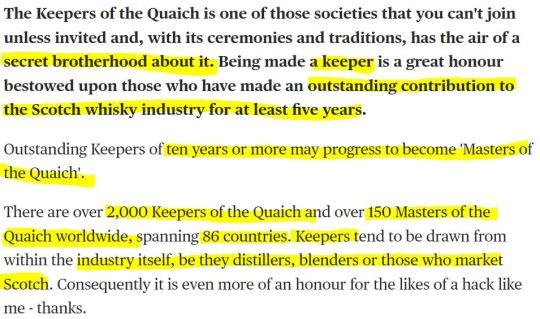
(Sourced at: https://www.diffordsguide.com/encyclopedia/341/people/keepers-of-the-quaich)
I first had a look at the list of its International Chapters and it is interesting to notice Muslim countries as Turkey or the Emirates each having their own chapter, which clearly tells me it's all about luxury and more specifically, luxury hospitality business, in that case. If inducted after the customary five years' wait, S could also make good use of the German chapter's (a market that proved to be very problematic for him) network, along with the Nordics and Netherlands, if he would think about cleverly expanding his trade in the EU. Last but not least, I would keep an eye on Brazil and India (along with the more predictable South Africa and Australia), because he already has a solid fanbase in the first one and well, Asia is always interesting, when it comes to alcohol business.
I did not really bother with the list of the Patrons, which spells a good and prestigious sliver of Debrett's Peerage's Scottish section. But I also looked at the list of the Management Committee, who does all the hands-on dealings and is directly responsible for the induction ceremony of new members. Aside from representatives of Diageo and Pernod Ricard (giants of the alcohol business world), a familiar name popped right at the bottom of the page:

Annabel Meikle, Director of The Keepers of the Quaich and as such, directly involved in the management of its activities (and probably also in all the underground shenanigans leading to the induction of new members, too). A great contact to have in your rolodex, judging by her public CV on LinkedIn:

Glenmorangie (also a member of the Keepers) - keep that reference under your sleeve, we are going to need it soon :).
Could she be related to...

I am leaving this without an answer, because I don't know and I will always refuse to go data mining for anything, but that sure as hell is not a common surname, as Smith or Martin!
At any rate, Mrs. Meikle is also (along with the Duke of Argyll, the current Keepers Grand Master) a member of The Scottish Committee of something very, very prestigious: The Worshipful Company of Distillers (https://www.distillers.org.uk/), based in London and founded in 1638, by Royal Charter (for “Body Politique and corporate” to govern the “Trade Arte and Mystery of Distillers of London” - how I love history, people!) granted by Charles I, a Stuart (of course). I am speculating and having visions of Livery status and Freedom of the City, followed by Knighthood for S (no bong needed, this particular narrative writes itself and believe it or not, it's not entirely without logic). And it is my strict constitutional right to be a poetic coo about it - that guy is smarter than we thought and I would curate that contact to death if I were him (but I am not, I am just a benevolent and intrigued observer, as you all know). Back to Earth from these optimistic conjectures, I will keep a tab on it, as I dutifully took note that one of their current interests is tequila:

Onwards to the US. We can have a fair idea of October 4th event just by looking at one of their few press releases on the occasion of the Chapter's launch gala, on September 25 2019, in New York (https://www.distilledspirits.org/wp-content/uploads/2019/10/KOTQUSA-Release-10.04.19.pdf - with quotes selected by me):



Moët Hennessy. Another reference to keep under our sleeve, for it will be soon very relevant. So yes, what has been speculated by Miss Marple is partially true: more business than aristocratic. But this is only if we do not consider as American aristocratic the venue of the next event. The Metropolitan Club is a very East Coast, WASP old money and (well, technically yes) Republican (but not MAGA Republican and this, to me, is very important for some reason) organization:

That was the state of play on Friday, folks, and I was already excited to share my optimistic findings with you. And then, C went to Paris and more dots started to speculatively connect. Bare with me for this long passegiata, I think it's worth it.
It was particularly important that C would be seen in a very friendly-casual pose with Delphine Arnault, out of all the other people attending that event. Not because Arnault is currently the big boss of Dior and Loewe (as I already explained here: https://www.tumblr.com/sgiandubh/729801825900953600/city-of-lights?source=share). And not only because C suddenly seems very interested to renew and expand her fashion days' old network. But also, because, as I already said, Delphine Arnault is also the daughter of her father and in France, business and family are always closely entwined. Always.
The French luxury market is roughly split between two behemoth players: Bernard Arnault (LVMH Moët Hennessy • Louis Vuitton S.A) and Antoine Pinault (Kering, ex- Pinault-Printemps- Redoute). These people and their businesses are number 1 and 2, respectively, on the global market. And out of these two, the only one very interested in the alcohol business is Arnault (Pinault does not deal in this sector).
So I took a look at his very diverse alcohol and spirits brand portfolio (25 references - https://www.lvmh.com/houses/wines-spirits/): rhum, brandy, champagne, tequila, wines (Argentina and even China). Two Scottish whisky brands: first Ardberg (the graceful peat from Islay). And - oh, hello, Mrs. Meikle - Glenmorangie, acquired by Arnault in 2004, after a bitter battle with Pernod Ricard (https://www.nytimes.com/2004/10/21/business/world-business-briefing-europe-france-scotch-maker-acquired.html):

Back at Mrs. Meikle's CV - hers was a pivotal role in the post-acquisition reshuffle, as part of LVMH:

Coincidence? I think not.
And then also a bourbon reference. Woodinville (based in the state of Washington, USA) with a pitch that made me grin again like the Cheshire Cat:

Sounds familiar? Rings a bell? See a pattern? You should: no, it's not S in disguise, but it could be SS in a couple of years, if S decided to sell it for a hefty profit.
But I was also interested in what is missing from this catalogue.
NO GIN.
Who knows? Maybe these French people could be enticed? In that case (and remember: I am SPECULATING), it would have to be a brand with a proven track record. You see, Arnault is famous for always buying only brands with a proven history and proven recognition (Tasting Alliance, anyone? LOL). Up until now and as is, FMN is just a pet project and a virtual endeavor. Nothing more and we shall see. But that little wild Scottish gin which could win hearts and already an award in Frisco is something completely different.
Now, then. You connect the dots. You draw your own conclusions. I see something very intriguing here and, as I already told you, the business underground situation is completely different from the bland façade.
You see, this is not about papers or checking a pulse or awkwardly grabbing a fist on some stairs. This is show me the money time. This is all about finding unexpected connections, at a very high level and on a very narrow niche.
So you think S and C can't stand each other anymore?
Humbug. They have each other's back from Day 1. And more. Ship on, ladies. Whatever clownery these days might bring, I know what I know. And by now, you should start asking yourselves the real questions, not if Waldo is with Carmen Sandiego (we KNOW), nor if they were online at the same time or not. I mean, that's cute: but to be honest, I think we're past that... uh... waypoint?
Next on my list is that Lallybroch trademark thing. This is the most complex one and I will take my time. I may speculate, but never without a logical base. And I always take these things very seriously.
Keepers of the Quaich, indeed. :)
248 notes
·
View notes
Text
Using my lunch break to do some snooping on the company that's bought Fusebox Games and what they have to offer and:
"We see a large opportunity in building an IP-based global gaming business that benefits from our core base in India, where we can support global studios through enhanced user acquisition strategies, data analytics, live operations, and new initiatives such as implementing our in-house AI playbook."
The CEO also "believes there are unlimited use cases of AI that the company can deploy" when making games, and also to "throw all the data being generated by the players during their activity to the AI to make a lot more personalized offerings which will help increase engagement as well as better monetization through advertising and user acquisition."
In other words, expect more AI. Not only for making the games either, but for using all the data generated when playing to try and get more money from the players (you all). I might do some more research on the company later, but I'm honestly just tired of all the fusebox bs – and not really active in the fandom anymore.
36 notes
·
View notes